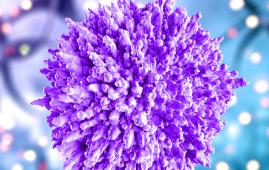

The entire coronavirus family has different ways of eluding the human defense system, and two new research have delved into how these viruses, notably SARS-CoV-2, use highly specialized enzymes to keep human immune forces at bay. The research shines a strong light on the subtle tactics used by coronaviruses to oppose and disrupt human cells, processes scripted in their genetic code that eventually let these viruses elude immune system attack. Some members of the coronavirus family use these techniques more effectively than others.
Indeed, one of the disturbing discoveries during the COVID pandemic has been the expanding arsenal of molecular techniques used by SARS-CoV-2 to evade the human immune system. By comparing the evasion skills of milder coronaviruses to the trio of coronaviruses known to cause serious, even death respiratory infections, new study from China has opened a window into an evasive technique in which coronaviruses disrupt human cells and damages jump forward.
“Coronaviruses that infect humans can cause either common colds … or severe respiratory symptoms,” noted Yuxian Xiong, lead author of one of the two studies reported in Science Signaling. Both research papers involve roughly the same team of scientists from numerous institutions in China, including State Key Laboratory of Chemical Oncogenomics in Guangdong and Peking University Shenzhen Graduate School, also in Guangdong.
Whether the coronavirus causes a normal cold or a catastrophic infection like COVID-19 or MERS, it all sets the foundation for immune evasion by disrupting essential human proteins that trigger the immune response. Coronaviruses use the same type of protein-cleaving enzyme to initiate their attack.
According to Xiong, there are seven coronaviruses that infect humans, four of which cause the common cold. HCoV-NL63, HCoV-229E, HCoV-HKU1, and HCoV-OC43 are the strains. SARS-CoV, the virus that caused the 2003 SARS epidemic; MERS-CoV, which surfaced in Saudi Arabia in 2012; and, of course, SARS-CoV-2, the virus that caused the COVID-19 pandemic.
The Guangdong researchers focused on viral enzymes known as papain-like proteases, which are protein-cleaving enzymes that developed to aid coronavirus survival by destroying essential signaling proteins that regulate human cells. When these enzymes target human cells, they become destabilized and lose their ability to mobilize innate immune system responses.
While these enzymes have been identified in the trio of severe coronaviruses, Xiong and colleagues have identified protein-like proteases—PLPs—in HCoV-229E, HCoV-HKU1, and HCoV-OC43, three common cold coronaviruses.
“We identified the PLPs of HCoV-229E, HCoV-HKU1, and HCoV-OC43 and found that their enzymatic properties correlated with their ability to suppress innate immune responses,” wrote Xiong. The innate immune response is the initial cascade of immune system constituents released by human cells in response to infection.
Xiong and colleagues demonstrate how coronaviruses use their PLPs to degrade ubiquitin and a similar ubiquitin-like protein termed ISG15. Ubiquitin and ISG15 are cell regulators in human cells. By destroying these regulatory proteins, the innate immune response is compromised, allowing viruses to multiply unchecked. PLPs are thought to be deubiquitinating and deISGylating agents.
Coronavirus deubiquitinating and deISGylating activity is critical in antagonizing the host’s immune system and may also facilitate coronavirus immune evasion, according to Xiong and colleagues.
In a second study published in the same publication, Dan Cao and colleagues explored how the SARS-CoV-2 PLP—Plpro—suppresses the type-1 interferon antiviral response in human cells. Interferon is a key player in the innate immune system’s activities.
Cao discovered that when Plpro infected human embryonic kidney cells, it deleted chains of ubiquitin proteins (deubiquitinated those proteins) from STING, a multiprotein complex in human cells that stands for Stimulator of Interferon Genes. STING is a 379 amino acid complex that plays an important role in the spread of antiviral responses.
Looked at another way, Cao and colleagues discovered how SARS-CoV-2 literally takes the sting out of the STING complex. “Because it is the first line of antiviral defense in humans, the type 1 interferon signaling pathway is one of the main targets of viral antagonism to facilitate immune evasion,” Cao asserted in the second Science Signaling study on PLPs and their capacity to elude human immune system activity. “Several SARS-CoV-2 proteins reportedly play antagonistic and evasion roles against interferon-1 responses.”
Cao and the Guangdong team also discovered that treating human lung airway cells with an activator of STING and a chemical that inhibits PLpro decreased SARS-CoV-2 multiplication in culture. The PLPs of six other coronaviruses that infect humans, as well as other SARS-CoV-2 variations of concern, were also investigated by the researchers. PLPs from all coronaviruses that infect humans became linked to STING and inhibited interferon responses, they discovered.
The discoveries are leading to new insights about the family of human-infecting coronaviruses as a whole. “SARS-CoV-2, SARS-CoV, and MERS encode only one PLP domain, namely, PLpro,” Xiong explained, referring to the trio of more dangerous types of coronaviruses. “By contrast, the mild coronavirus NL63 contains two PLP domains, PLP1 and PLP2, but only PLP2 has been reported to have deubiquitinating activity.”
Having these new discoveries in hand may eventually lead to improved antiviral therapies for existing coronaviruses and even future threats from this family of pathogens, Xiong and Cao say.
more recommended stories
 Neoadjuvant Chemotherapy Boosts Ovarian Cancer
Neoadjuvant Chemotherapy Boosts Ovarian CancerDuring the COVID-19 pandemic, US women.
 Brain Connectivity Unveils New Insights into Autism
Brain Connectivity Unveils New Insights into AutismBecause autism spectrum disease symptoms can.
 AI Tool Predicts Cancer Therapy Responses Using Tumor Cell Data
AI Tool Predicts Cancer Therapy Responses Using Tumor Cell DataWith over 200 types of cancer,.
 Nutrient Optimization: Vitamin D for Health
Nutrient Optimization: Vitamin D for HealthResearchers addressed the prevalence of vitamin.
 AD and Headache Disorders: Recent Findings
AD and Headache Disorders: Recent FindingsAtopic dermatitis (AD) patients may be.
 DASH Diet Reduces Cardiovascular Disease Risk in Breast Cancer Survivors
DASH Diet Reduces Cardiovascular Disease Risk in Breast Cancer SurvivorsA recent publication in JNCI Cancer.
 Myasthenia Gravis Treatment: Eculizumab & Ravulizumab
Myasthenia Gravis Treatment: Eculizumab & RavulizumabA recent study found that myasthenia.
 Heart Failure Treatment Advancements
Heart Failure Treatment AdvancementsIn a recent report published in.
 Altered Emotional Body Sensations in Parkinson’s Disease
Altered Emotional Body Sensations in Parkinson’s DiseaseEmotions wield considerable influence over our.
 Nasal Cellular Age response to Covid 19
Nasal Cellular Age response to Covid 19Variations in Nasal Cellular Age Response.

Leave a Comment